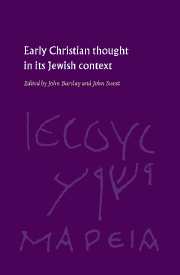Book contents
- Frontmatter
- Contents
- List of contributors
- Preface
- List of works by Morna D. Hooker
- List of abbreviations
- Chapter 1 Introductory Essay
- I THE SOCIAL CONTEXT OF EARLY CHRISTIANITY
- II SOME EARLY CHRISTIAN SOURCES
- Chapter 4 Jesus
- Chapter 5 Matthew
- Chapter 6 Mark
- Chapter 7 Luke–Acts
- Chapter 8 John
- Chapter 9 Paul
- Chapter 10 Deutero-Pauline letters
- Chapter 11 Hebrews
- Chapter 12 Revelation
- Chapter 13 Other early Christian writings: ‘Didache’, Ignatius, ‘Barnabas’, Justin Martyr
- III SOME EARLY CHRISTIAN THEMES
- Index of names
- Index of subjects
- Index of texts
Chapter 13 - Other early Christian writings: ‘Didache’, Ignatius, ‘Barnabas’, Justin Martyr
from II - SOME EARLY CHRISTIAN SOURCES
Published online by Cambridge University Press: 22 September 2009
- Frontmatter
- Contents
- List of contributors
- Preface
- List of works by Morna D. Hooker
- List of abbreviations
- Chapter 1 Introductory Essay
- I THE SOCIAL CONTEXT OF EARLY CHRISTIANITY
- II SOME EARLY CHRISTIAN SOURCES
- Chapter 4 Jesus
- Chapter 5 Matthew
- Chapter 6 Mark
- Chapter 7 Luke–Acts
- Chapter 8 John
- Chapter 9 Paul
- Chapter 10 Deutero-Pauline letters
- Chapter 11 Hebrews
- Chapter 12 Revelation
- Chapter 13 Other early Christian writings: ‘Didache’, Ignatius, ‘Barnabas’, Justin Martyr
- III SOME EARLY CHRISTIAN THEMES
- Index of names
- Index of subjects
- Index of texts
Summary
Almost every page of the New Testament confirms that the first followers of Jesus drew deeply on their biblical and Jewish heritage and also developed their own distinctive patterns of thought and of community life. Important evidence for the student of the continuity and discontinuity of early Christian thought with its Jewish context is also found in many second century Christian writings. They often spell out explicitly what is only implicit in New Testament writings; careful study of them often leads to fresh insights into the more familiar New Testament writings.
In this chapter I shall concentrate on four very different second century writings. They have been chosen partly because of their closeness in various ways to New Testament writings, and partly because they are representative of the varied attitudes to Judaism found in second century Christian writings.
THE DIDACHE
In this fascinating and puzzling manual of early church instruction and discipline, some passages are thoroughly Jewish, some are distinctively Christian, and in some there are hints of Christian anti-Jewish polemic. The final redaction of the Didache seems to have taken place in the early decades of the second century.
Continuity: ethical teaching
In the opening six chapters (about one third of the whole writing) traditional Jewish ethical teaching has been lightly ‘Christianized’. ‘Two ways’ are contrasted: the characteristics of the ‘way of life’ are set out in chapters 1–4, and the sinful acts which are the ‘way of death’ are listed in chapter 5.
- Type
- Chapter
- Information
- Early Christian Thought in its Jewish Context , pp. 174 - 190Publisher: Cambridge University PressPrint publication year: 1996



